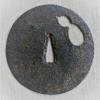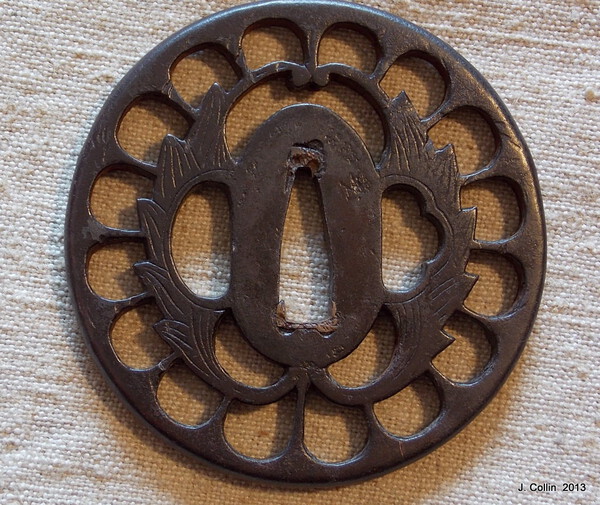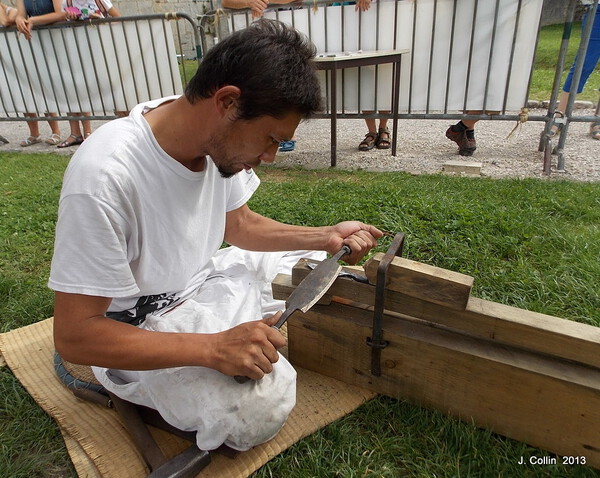-
Posts
5,967 -
Joined
-
Last visited
-
Days Won
19
Content Type
Profiles
Forums
Events
Store
Downloads
Gallery
Everything posted by ROKUJURO
-
Jason, if you turn the photo 90° to the right you may probably see a NATA, a Japanese hatchet. It is frequently seen, I even have a TSUBA with a NATA for sale.
-
It is probably FURUZAWA.
-
Guido, Ian was faster than me and gave a basic description. Not too much is known about how exactly the Chinese proceeded, but today we know what is necessary to decarburize cast iron to produce the desired material. It is not necessary to copy the text here, it can be read under http://en.wikipedia.org/wiki/Malleable_iron.
-
You are missing what Ian refers to: Decarburization is done with cast iron which has a very high carbon content (up to 4 -5 %). If the process is controlled, the result will be malleable cast iron which has a number of useful applications. Decarburization of a tool steel (having roughly about 0.5 to 1.3 % carbon) will indeed result in a lower quality with loss of strength and possible hardness. The whole discussion is useless without practical experience and profound knowledge of metallurgy. Exchange of opinions will not lead to better knowledge.
-
Craig, the TSUBA could be the best part of the package, but we would need good enlarged photos for a comment. The TSUKA is about the size of the short NAKAGO which has obviously been messed with as already stated. The TSUKA ITO has not been wrapped in the correct way which is food for the thought that the whole set has been put together. The blade might have suffered from a broken KISSAKI and a subsequent amateurish try to fix the damage. Just my thoughts, not an evaluation.
-
As usual, it depends on what you see in it and what you can do with it. The seller states:...Having value for research and study purposes..... I would use it that way or as raw material to forge knife blades from it. A repair is out of any possibility, but I have seen blades with a nice NAKAGO welded to them. It was usually well made but in most cases still detectable.
-
The delivery of that blade will be a shock for the new owner because FedEx is dedicated fright service... (from the seller's description)
-

This is my favourite piece.
ROKUJURO replied to Nickupero's topic in General Nihonto Related Discussion
Gentlemen, this TSUBA is perhaps not a splendid one, but I like it: It measures 75,4 by 75 mm and is 5 mm thick. The colour is an even dark chocolate brown, the design is KIKU to MYOGA. I was told that it might belong to a HIGO sideline school, dating in the early EDO period. Any comment is welcome. -
Chris' message can only be underlined. I think the key to many visual effects on a blade does not lie in the aesthetic approach and guesses about their origin but in a deep understanding of the qualities and reactions of steel. In the manufacture of a sword blade, a very large number of facts and fundamentals have to be looked at and experienced, and if you are not deeply familiar with every aspect of the forge, you might miss important points. Looking at a blade without this knowledge is close to Platon's allegory of the cave: You can discuss endlessly without really getting to a result that is supported by reproducible evidence. If I may just grab the term UTSURI from the discussion: We know where we can see it, we also know that it cannot be seen in a bad polish, and we have assumptions of how it might have been produced, but in the end we do not know for sure. It may have been influenced by a special material source, but if we look at the perfection of a really well made blade, we know that the KAWAGANE was sometimes very thin over a complex SHINGANE core, and so we have also to take carbon diffusion into account. I don't say that this is the solution, I only want to mention that lots of facts may be hidden under the surface and need more research before we can make statements. This may be a bad example as I don't know if nowadays' swordsmiths can produce UTSURI and know the facts, but I wanted to stress that we need competence for a judgement. A famous Chinese painter once said to his pupil: You will only be able to paint bamboo after you have become a bamboo.
-
Grev, very good and useful work! Thanks for your effort! Thanks also to MORITA-SAN and Brian for the adaptations.
-

KOKUSAI TOSOGU KAI
ROKUJURO replied to ROKUJURO's topic in Sword Shows, Events, Community News and Legislation Issues
David, yes, that might be interesting, but sorry, I don't know if he has a collection at all. And if he had, you cannot be sure that he wants to show off his treasures. -
Gentlemen, it may be of interest that a member of the KTK, HONAMI KOSHU-SAN, was selected as one of seven people to be designated as a Living National Treasure on July 18, 2014. As you know, the HONAMI family has a long tradition of excellence in the fields of sword polishing and appraisal. KTK is happy to learn that his significant contributions to those important fields of work have been recognized and that HONAMI-SAN has been so honored by Japan's Council for Cultural Affairs.
-

Unsigned tsuba and single menuki for sale
ROKUJURO replied to bigjohnshea's topic in For Sale or Trade
I think this was a MOKUME-GANE TSUBA, made with copper and silver. The whirls design was not made fully intentionally as we see it in inlay, it can be part of the making process. The pitting holes are probably not only caused by corrosion but by unsufficient bonding of the metals in the first place. To an extent they may have formed later by artificial patination. Usually there is no solder being used in the making of MOKUME-GANE. -
Gentlemen, this wood is probably not of Japanese origin but some Asian wood as imports from Africa might have been difficult and unlikely in former times. It certainly is not Padouk which has a reddish colour to it, or HINOKI which is a soft wood with a more homogenous colour. I have samples of all these woods in my shop. From the looks it could also be Burmese Blackwood (Dalbergia) and this could have been available to Japanese craftsmen. But these are all guesses, a Japanese specialist will definitely know better.
-
Robert, if you follow my instructions, there is no danger of damaging the blade. You are certainly not going to file on the blade but just test if the file gets a 'grip'. As I wrote, a fine metal file in good condition will work. A penny will not work as it is copper (at least it was in my youth), so the hardness difference is way too big. Any steel is harder than a penny. A hardness testing device is a good thing when you need exact hardness data. You can find them at some upper level knifemakers', or as Chris said, at a machining shop, or of course at a hardening shop. A Rockwell measuring device will leave a very small indentation from a tiny diamond (http://en.wikipedia.org/wiki/Rockwell_scale) which will disappear in a polish.
-
Ron, both look strongly like Wenge (http://en.wikipedia.org/wiki/Millettia_laurentii), an African hardwood.
-
Robert, it is very easy to test the hardness of the edge, and you can do it yourself without great damage - nevertheless a scratch may be the result. It is done in every blacksmith's shop as a normal test after quenching a blade. You take a fine new (or nearly new) metal file and try to file the edge in an angle as if you wanted to sharpen the blade. Don't use too much presssure, you will feel immediately if the file ''bites'' (which would mean a non-hardened edge) or if it ''slides'' on the HA without removing metal. It is a feeling as if you filed glass. Carefully done, this action remains almost without any visual effect or damage on the blade if hardened, and in the other case it will leave a few tiny scratches. Do this in hand, not in a vise, and do it close to the HAMACHI! As the edge is still dull, this test will not harm your blade. The technical background is that the hardness of a quality file is about 65 to 67 HRc (Rockwell hardness), while a correctly hardened Japanese blade has about 60 HRc. A non-hardened cutting edge as it comes from the anvil may have about 40 HRc. A finished (hard) blade can only be filed with a diamond file or ground and polished with stones, be that artificial or natural. Before quenching, a Japanese sword blade is treated in a way to make the steel soft so it can be formed with a SEN (see attached photo). My guess from what is visible of the blade, the traces on the surface, and its shape (SORI) is that is is not hardened, but the file test will definitely show. Best of luck! So, gentlemen, this is the ultimate test for your JUYO blades! Are they REALLY hard?
-
Curtis, have a good look at the SORI and compare with KOTO blades.
-
Trent, I want to underline what Brian said. The thought of preserving and caring for NIHONTO requires knowledge, respect, and a certain humility when dealing with any traditionally handmade blade, not depending on its age or what it was purchased for. In your phantasy or your dreams you may feel like a SAMURAI, but in your dreams you don't damage good blades. By the way, you should not try to cut bamboo mats. The traditional material is TATAMI OMOTE, a kind of rush. And of course you don't start any form of NIHONTO training with a sharp blade! Mouvements and muscles are trained with BOKKEN or a similar 'tool'.
-
Zhang, is this a Japanese blade? Seems unusually heavy, and the edge should not have a mirror polish. At least this is what I am used to see.
-
Jean, that was probably an original KUSARI-GAMA with JUYO papers? :D
-
Birdhunter, Please: NEVER touch a blade with your bare hands Sign all messages with a real first name and an initial as per the forum's rules. The blade is a Japanese TANTO. Unfortunately, someone without any knowledge has polished the blade and possibly ruined it. The shape has been altered and it might be very difficult and expensive to restore it, if at all possible. I suggest you look for a knowledgeable NMB member near your place to ask for further advice, you go to a Japanese sword show, or you look for a NIHONTO club in your neighbourhood. Best of luck!




